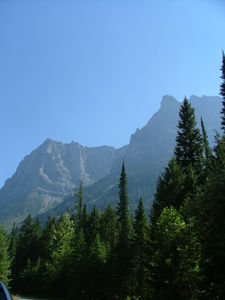Advertisement
Published: September 2nd 2007

 The Mountain View
The Mountain View
There are so many mountain peaks here that it is impossible to remember the names of them all. The local forest fires have left a smokey haze over this area.America's 390 National Parks preserve and respect our shared heritage and resources. Glacier National Park is one of our favorite parks in the United States. Glacier National Park encompasses a region of mountains in the northwest corner of Montana that abuts Waterton Lakes National Park in southwestern Alberta, Canada.
The Going-to-the-Sun Hiway is truly an engineering marvel. One of the most beautiful pieces of mountain road in the world, as it meanders through the heart of the park and up the steep slopes of the Continental Divide and over 2,026 meter (6,646 foot) Logan Pass.
Construction on the road began in 1921 and continued until 1937. It is considered a National Civil Engineering Landmark and marvel of engineering. This road abandoned construction norms of the time and embraced a newly adopted NPS policy that stressed the importance of harmonizing park improvements with the landscape around it.
The high-mountain section over Logan Pass was built into the sides of near-vertical cliffs using a network of stonemasonry bridges, tunnels and arches. A series of 130 retaining walls support the roadbed along the steepest sections and more than 7 miles of guard walls and guardrails help guide motorists and keep them

 West Glacier Entrance
West Glacier Entrance
We entered Glacier National Park through the West Glacier Entrance and drove the Going-to-the-Sun road over to St. Mary's and back. It is said that one must see the park in the morning and the afternoon sun to see the changes the light makes on the mountains. on the road. In many places on this hiway, there is barely room enough for two cars to pass with the sides of the mountain jutting outward over the roof of your vehicle. Thus, no motorhomes or buses are allowed on this hiway. These stone masonry guard walls give the road much of its historic character and architectural aesthetic appeal.
Seventy years of rockslides and avalanches, sever weather with up to 60 plus feet of snow per year, heavy traffic and inadequate maintenance left the road in urgent need of repair.
Without agressive action, the historic structures for which the Going-to-the-Sun Road is so admired might have been lost forever. This repair work could take another 10 years to complete as the season for repairing the roads and bridges is so short from June to September and there is much work to be done.
Thus, the road is currently under repair 24/7 while keeping one lane of the road open in places so that the tourists can still enjoy this marvelous drive. Even though we were delayed only 15 minutes in each direction of the drive, it was good to remember that we were seeing a project of

 Lake McDonald
Lake McDonald
Our first stop was Lake McDonald. The water is so clear here you can see a dollar bill and actually read the print when it is placed two feet underwater!unprecedented scope and magnitude and we were witnessing history remade!
This drive is not something we can actually capture on film. Even though you will see the pictures here, they do not do it justice. Even the finest cameras cannot record all that the eye can see. This is a magnificent sight to see. If you have not seen Glacier National Park and driven Going-to-the-Sun Hiway, then we highly recommend you do so. The glaciers are rapidly disappearing and are expected to be completely gone by the year 2030.
There is so much to do here in the park. Hiking trails go throughout the park and some of them are on the mountainside above the roads! Biking, rafting, fishing, boating, hunting, you name it, and if it is an outdoor sport, they have it all here.
When driving this highway, you really feel that you are truly "going to the sun" !
Advertisement
Tot: 2.059s; Tpl: 0.013s; cc: 5; qc: 54; dbt: 0.0731s; 1; m:domysql w:travelblog (10.17.0.13); sld: 1;
; mem: 1.1mb

 The Mountain View
The Mountain View
 West Glacier Entrance
West Glacier Entrance
 Lake McDonald
Lake McDonald




































